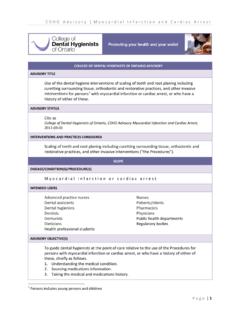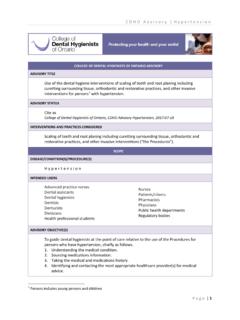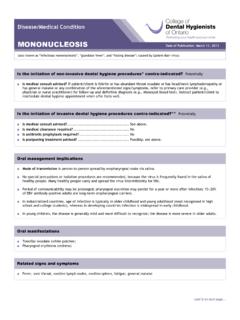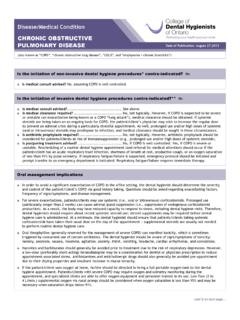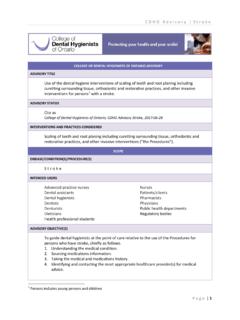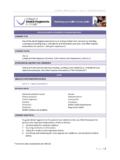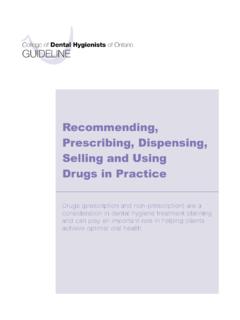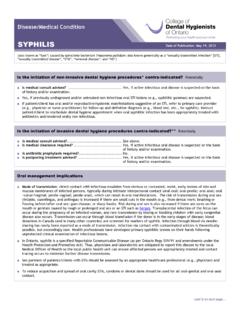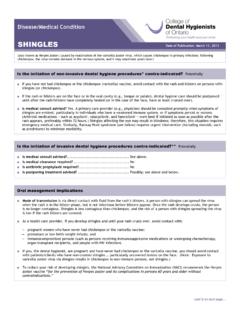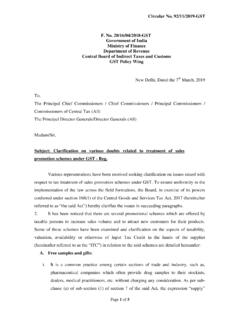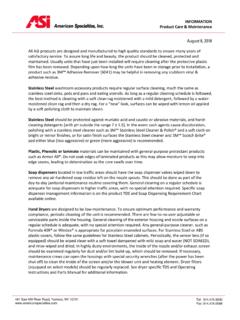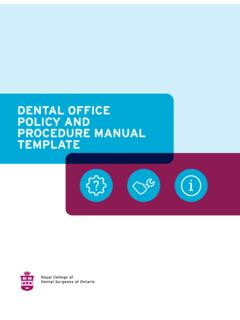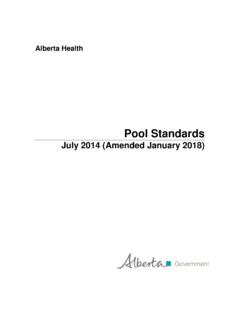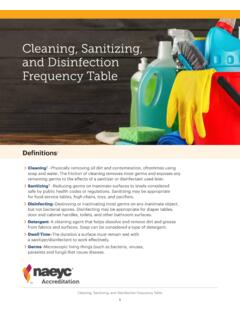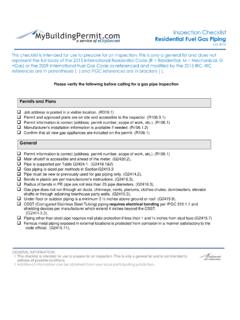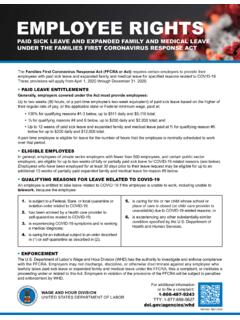Transcription of Infection Prevention and Control (IPAC) Guidelines - CDHO
1 Infection Prevention and Control (IPAC) Guidelines Last Revision: August 3, 2022 First Published: December 2018 Revised: September 2019; August 2022 2022, College of Dental Hygienists of Ontario CDHO Infection Prevention and Control (IPAC) Guidelines 1 Table of Contents Introduction .. 4 Professional and Regulatory Considerations .. 5 Written Policies and Procedures .. 6 Occupational Health and Safety Requirements and Workplace Hazardous Information System (WHMIS) .. 8 Human Rights .. 10 Transmission of Microorganisms .. 11 Oral Health Care Provider and Client Safety .. 13 Routine Practices .. 13 Risk Assessment .. 13 Hand Hygiene .. 14 Alcohol-Based Hand Rub vs Soap and Water .. 15 Effective Hand Hygiene Techniques .. 16 Barriers to Effective Hand Hygiene.
2 17 Personal Protective Equipment (PPE) .. 18 General Considerations .. 18 Protective Covering .. 18 Masks .. 19 Protective Eyewear .. 19 Gloves .. 20 Environmental Controls .. 23 Handling of Sharps and Exposure Prevention .. 23 Exposure Management .. 24 Administrative Controls .. 25 Education and Training .. 25 Immunization .. 25 Illness and Work Restrictions .. 25 Additional Precautions .. 26 Reprocessing .. 27 Classification of Client Care Equipment .. 28 Single-Use Items/Devices .. 28 Reprocessing Area .. 29 Cleaning Reusable Dental Instruments/Devices .. 30 CDHO Infection Prevention and Control (IPAC) Guidelines 2 Manual Cleaning .. 30 Ultrasonic Cleaner .. 31 Washer-Disinfectors .. 31 Disinfection .. 31 Low to Intermediate Level.
3 31 High Level (Cold Soak) .. 32 Preparing and Packaging of Reusable Dental Instruments/Devices .. 32 Sterilization of Reusable Dental Instruments/Devices .. 34 Steam Sterilization .. 34 Unacceptable Methods of Sterilization .. 35 Flash Sterilization .. 35 Monitoring .. 36 Determining the Effectiveness of the Steam Sterilization Process .. 36 Process Challenge Devices (PCD) .. 37 Air Removal/Bowie-Dick PCD Test Pack .. 38 Biological Indicator PCD Test Pack .. 38 Biological Indicator PCD Failure .. 39 Chemical Indicator PCD Test Pack .. 40 CI, CI PCD and/or Physical Parameters Failures .. 40 Logging the Sterilization Process .. 43 Documenting a Recall Incident .. 43 Qualifying and Requalifying Your Sterilizer .. 43 Storage of Reprocessed Dental Instruments / Single-Use Devices.
4 44 Environmental Cleaning .. 45 Public Contact Surfaces .. 45 Clinical Contact Surfaces .. 45 Barriers .. 46 Waste Management .. 47 Biomedical Waste .. 47 General Office Waste .. 48 Disposal of Teeth .. 48 Mercury-Containing Waste Protocol .. 48 CDHO Infection Prevention and Control (IPAC) Guidelines 3 Special Considerations .. 49 Dental Unit Waterlines .. 49 Devices with Lumens .. 50 Dental Handpieces and Other Devices .. 50 Ventilation .. 51 Boil-Water Advisory .. 51 Saliva Ejectors and Suction Lines .. 51 Radiography Equipment .. 51 Film .. 51 Digital Radiography .. 52 Intraoral Cameras .. 52 Lasers .. 52 Sharpening Stones .. 52 Injectable Medications, Vials and Solutions .. 53 Dental Laboratory .. 53 Sending Items to a Commercial Lab.
5 53 Receiving Items from a Commercial Lab .. 53 Sending Items Out for Repair and/or Maintenance .. 53 Resources .. 55 Glossary .. 57 CDHO Infection Prevention and Control (IPAC) Guidelines 4 Introduction Oral health care workers (OHCW) have an obligation to their clients to establish and maintain practice environments that have organizational structures, policies and resources in place that are consistent with legal, professional and ethical responsibilities that promote safety, respect, and support for all persons within the practice setting. An OHCW meets this practice standard by: ensuring that all legislative requirements are met ensuring written policies and protocols are in place for the practice environment, such as workplace health and safety, Infection Prevention and Control , managing hazardous wastes, and respecting human rights maintaining facilities, equipment, supplies and technology sufficient to provide a full scope of practice safely and effectively securing and maintaining appropriate service schedules and service records ensuring that current scientifically accepted Infection Prevention and Control practices are in place.
6 CDHO Infection Prevention and Control (IPAC) Guidelines 5 Professional and Regulatory Considerations These Guidelines contain Infection Prevention and Control (IPAC) best practice recommendations which must be followed by all dental hygienists practising in Ontario while providing client care. The CDHO s Infection Prevention and Control Guidelines are consistent with guidance documents from Public Health Ontario (PHO), the Public Health Agency of Canada (PHAC), the Provincial Infectious Disease Advisory Committee (PIDAC) and the Canadian Standards Association (CSA). This document will be used by the College of Dental Hygienists of Ontario and/or may be used by others in determining whether appropriate standards of practice and professional responsibilities have been implemented and maintained.
7 The CDHO recognizes that this aspect of practice is constantly evolving, therefore, this document presents best practices at the time of publication and will be amended as new information becomes available. CDHO Infection Prevention and Control (IPAC) Guidelines 6 Written Policies and Procedures According to PIDAC, CSA and PHAC, all oral health care workers are required to establish and document practice-specific written policies and procedures that are based on current recognized standards and best practices. A policy and procedure manual for up-to-date IPAC protocols must be followed by all OHCWs, reviewed at least annually or more frequently as new information becomes available, and must address the following: requirements for education and training of all OHCWs, including a process for continual improvement.
8 And documentation of quality improvement IPAC goals immunization and vaccination status of OHCWs routine practices such as o hand hygiene o risk assessment o appropriate selection of personal protective equipment all aspects of the reprocessing of dental hygiene instruments/devices including o the employment of single-use items when dental equipment/devices cannot be cleaned and reprocessed according to the recommended standards o the removal of faulty instruments/devices until repaired or replaced o the documentation of maintenance and repair of all cleaning and sterilization equipment kept for 10 years as indicated in the CDHO Records Regulation o quality monitoring and documentation of the reprocessing procedure including biological indicator tests, chemical indicator tests, and physical parameters.
9 (All test results must be logged, evaluated after each cycle, signed by the person responsible, and kept for 10 years as per the CDHO Records Regulation.) o information to be recorded on instrument packages which must include a sterilizer number, load number and date of sterilization, load contents, and person who assembled the package o a recall of improperly reprocessed equipment that includes notification of the appropriate authorities, assessment of client risk, and determining if additional notification of client, other facilities, and/or regulatory bodies ( public health unit, regulatory college) is required o a documented auditing process of competency of OHCWs involved in reprocessing and IPAC procedures, including corrective measures if needed o a regular schedule for environmental cleaning of the reprocessing area that includes clearly defined responsibilities managing hazardous waste (biohazardous, mercury, lead, sharps) CDHO Infection Prevention and Control (IPAC) Guidelines 7 water and water use within the dental setting o for maintaining dental unit waterline quality o during a Boil-Water Advisory (Safe Drinking Water Act, 2002, Ontario Regulation 169/03 regulatory standards for drinking water)
10 Suction and suction line maintenance procedure for immediate containment, cleaning and disinfection of spills of blood and body fluids facilities maintenance (environmental cleaning, even if contracted out), such as o a detailed schedule of cleaning of each area of the clinic o sufficient equipment, supplies and technology for all areas requiring environmental cleaning o the maintenance of appropriate service schedules and service records. CDHO Infection Prevention and Control (IPAC) Guidelines 8 Occupational Health and Safety Requirements and Workplace Hazardous Information System (WHMIS) In Ontario, employers have the responsibility to meet the requirements of the Occupational Health and Safety Act (OHSA) which includes the Ontario Regulation 860: Workplace Hazardous Materials Information System (WHMIS).

